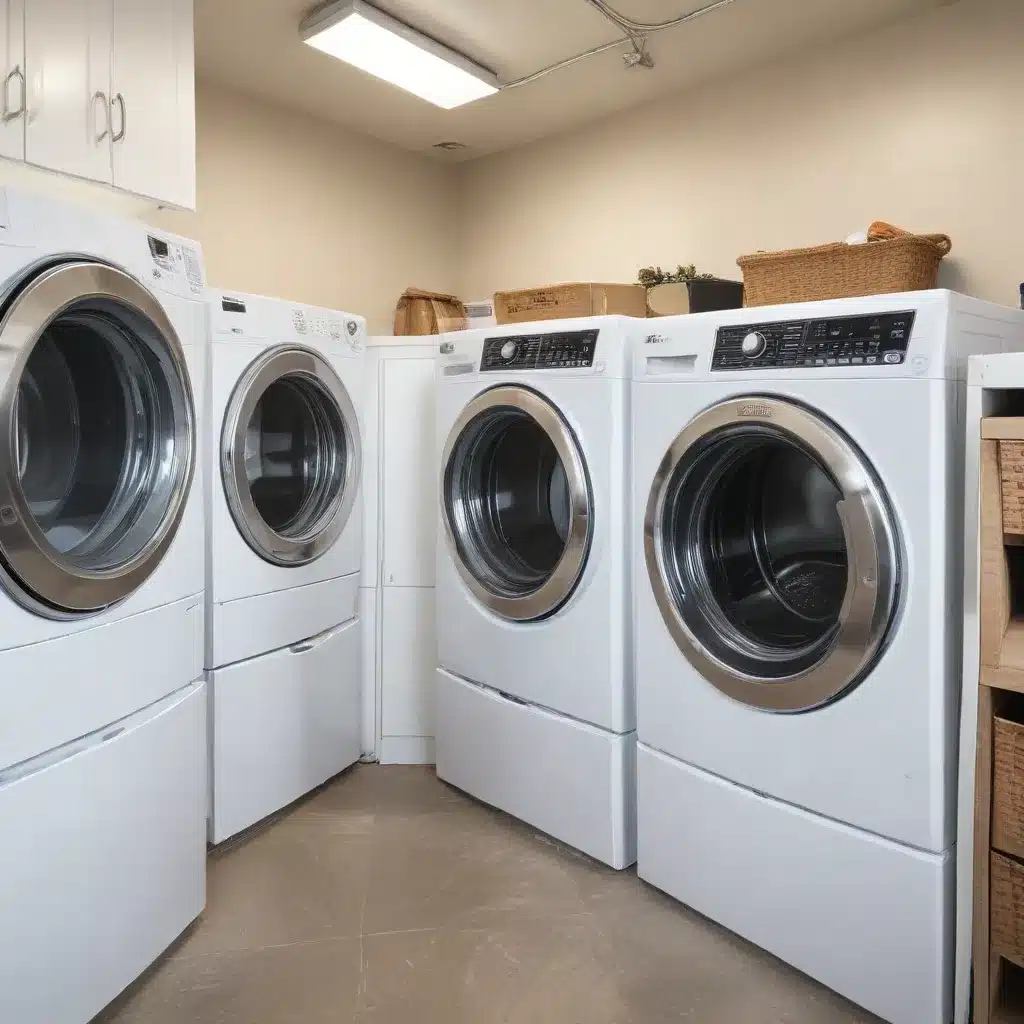
The Importance of Water-Efficient Laundry Appliances
As a seasoned expert in plumbing and heating services, I understand the significant impact that laundry operations can have on a household’s water and energy usage. The average American family washes around 300 loads of laundry per year, making it one of the most resource-intensive chores in the home. However, with the advent of advanced, water-efficient washing machines, there are now ample opportunities to reduce your environmental footprint and lower your utility bills.
One of the simplest ways to save both water and energy is to upgrade to a WaterSense-labeled clothes washer. These high-efficiency models use 13 gallons of water per load, compared to the 23 gallons used by a standard washing machine. That’s a remarkable 3,000-gallon annual water savings for the average family! Additionally, ENERGY STAR-certified washers can help reduce your energy costs, as they use significantly less electricity to heat and circulate the water.
Understanding Water and Energy Savings
The water-energy nexus is a critical consideration when choosing laundry appliances. It takes a substantial amount of energy to deliver and treat the water used in our homes, with homes with electric water heaters spending a quarter of their electricity bill just to heat water. By reducing water consumption through efficient washing machines, you can directly lower your energy bills as well.
In fact, the U.S. Department of Energy estimates that if every clothes washer purchased in the U.S. was ENERGY STAR certified, we could save more than $4 billion each year and prevent more than 19 billion pounds of annual greenhouse gas emissions – the equivalent of taking 1.8 million cars off the road.
The water savings from upgrading to a water-efficient washing machine can be quite significant. A full-sized ENERGY STAR certified clothes washer uses 13 gallons of water per load, compared to the 23 gallons used by a standard machine. Over the course of a year, that translates to a water savings of more than 3,000 gallons per household.
Rebates and Incentives for Efficient Laundry Upgrades
Fortunately, many local water and utility providers offer rebates and incentives to encourage residents to adopt water-efficient appliances and equipment. For example, the SoCal Water$mart program provides rebates for customers who upgrade to high-efficiency clothes washers that meet or exceed the Consortium for Energy Efficiency (CEE) Tier 1 standard.
Similarly, the San Francisco Public Utilities Commission (SFPUC) offers two types of commercial equipment rebates for businesses and facilities looking to improve the water efficiency of their laundry operations. The Metered Water Savings rebate provides a higher rate of $7 per 748 gallons of water saved over a 10-year period, while the Estimated Water Savings rebate offers a fixed amount per equipment type, up to 50% of the purchase cost.
These types of rebate programs can significantly offset the initial investment in a new water-efficient washing machine, making the upgrade more accessible and financially viable for homeowners and businesses alike. It’s always worth checking with your local utility or water provider to see what incentives may be available in your area.
Choosing the Right Water-Efficient Washing Machine
When selecting a new water-efficient washing machine, there are a few key factors to consider:
-
Water Efficiency: Look for the WaterSense label, which indicates the appliance meets the EPA’s criteria for water efficiency and performance. WaterSense-labeled washers use at least 25% less water than the federal standard.
-
Energy Efficiency: Pair your water-efficient washer with an ENERGY STAR-certified model to maximize your energy savings. These appliances are designed to use significantly less electricity than standard washers.
-
Capacity: Choose a washer size that aligns with your household’s laundry needs. Larger capacity models can handle bigger loads, potentially reducing the number of cycles required and saving more water and energy over time.
-
Cycle Options: Consider the available wash cycles and their water usage. Some models offer specialty cycles like “eco-mode” or “low-water” options that can further optimize water consumption.
-
Maintenance and Lifespan: Research the expected lifespan and maintenance requirements of different washing machine models to ensure you select a reliable and durable appliance.
By carefully evaluating these factors, you can find a water-efficient washing machine that not only saves resources but also delivers the performance and features your household requires.
Sustainable Laundry Practices Beyond Appliances
While upgrading to a water-efficient washing machine is a significant step, there are several other sustainable laundry practices you can implement to further reduce your environmental impact and utility costs:
- Use Cold Water: Washing clothes in cold water can save a significant amount of energy compared to hot water cycles, without compromising cleaning performance.
- Avoid Overloading: Ensure you’re using the appropriate load size for your washing machine’s capacity to optimize water and energy usage.
- Choose Eco-Friendly Detergents: Look for laundry products that are free of harsh chemicals and fragrances, which can be harmful to the environment.
- Air Dry When Possible: Using a clothesline or drying rack to air dry your clothes can significantly reduce your energy consumption from clothes dryers.
- Maintain Your Appliances: Regular maintenance, such as cleaning lint traps and checking for leaks, can help keep your washing machine and dryer running efficiently.
By implementing these sustainable laundry practices in conjunction with a water-efficient washing machine, you can maximize your environmental and financial savings.
Conclusion
Upgrading to a water-efficient washing machine is a straightforward and impactful way to reduce your household’s water and energy usage, while also lowering your utility bills. By taking advantage of available rebates and incentives, you can make the transition to a more sustainable laundry setup even more accessible.
Remember, water and energy conservation go hand-in-hand, and the choices you make in your laundry room can have a significant ripple effect on your overall environmental footprint. So, if you’re ready to upgrade your laundry room and start saving, be sure to visit https://ddplumbingandheating.co.uk/ to learn more about our expert plumbing and heating services.


